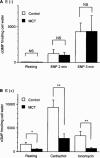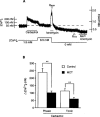Mechanisms underlying the impairment of endothelium-dependent relaxation in the pulmonary artery of monocrotaline-induced pulmonary hypertensive rats
- PMID: 10556948
- PMCID: PMC1571722
- DOI: 10.1038/sj.bjp.0702878
Mechanisms underlying the impairment of endothelium-dependent relaxation in the pulmonary artery of monocrotaline-induced pulmonary hypertensive rats
Abstract
1. It has been reported that endothelium-dependent relaxation is impaired in pulmonary hypertensive vessels. The underlying mechanisms for this phenomenon, however, have not yet been identified. In this study, the mechanisms responsible for decreased endothelium-dependent relaxation in the pulmonary artery isolated from monocrotaline (MCT)-induced pulmonary hypertensive rat (MCT rat) were examined. MCT (60 mg kg-1), or its vehicle was administered by a single subcutaneous injection to 6-week-old male Sprague Dawley rats. 2. Endothelium-dependent relaxation induced by carbachol or ionomycin in the MCT rat artery was significantly smaller than that in vehicle-treated rat (control rat) artery. Cyclic GMP levels, measured by enzyme-immunoassay, under resting or stimulation with carbachol or ionomycin were also smaller in the MCT rat artery. However, sodium nitroprusside-induced cyclic GMP accumulation in the endothelium-denuded artery was similar in control and MCT rats. These results suggest that MCT treatment decreases endothelial nitric oxide (NO) production. 3. Resting endothelial Ca2+ levels ([Ca2+]i) in the fura-PE3-loaded MCT rat artery, were not different from those in the control rat. However, the increase in endothelial [Ca2+]i elicited by carbachol was attenuated in the MCT rat. 4. In quantitative RT - PCR analysis, the expression of mRNA encoding endothelial NO synthase was rather increased in the MCT rat artery, suggesting an up-regulation of eNOS expression. 5. These results provide evidence that impaired NO-mediated arterial relaxation in the MCT rat is due to dissociation between eNOS expression and NO production. This dissociation may be derived from an inhibition of receptor-mediated Ca2+ metabolism and also from the apparent decrease in Ca2+ sensitivity of eNOS.
Figures




Similar articles
-
Effects of atorvastatin and L-arginine treatments on electrical field stimulation-mediated relaxations in pulmonary arterial rings of monocrotaline-induced pulmonary hypertensive rats.J Cardiovasc Pharmacol. 2010 Nov;56(5):498-505. doi: 10.1097/FJC.0b013e3181f4838b. J Cardiovasc Pharmacol. 2010. PMID: 20729759
-
[TRPC6 mediates the enhancements of pulmonary arterial tone and intracellular Ca2+ concentration of pulmonary arterial smooth muscle cells in pulmonary hypertension rats].Sheng Li Xue Bao. 2010 Feb 25;62(1):55-62. Sheng Li Xue Bao. 2010. PMID: 20179889 Chinese.
-
Activity of endothelium-derived hyperpolarizing factor is augmented in monocrotaline-induced pulmonary hypertension of rat lungs.J Vasc Res. 2007;44(4):325-35. doi: 10.1159/000101778. Epub 2007 Apr 16. J Vasc Res. 2007. PMID: 17438361
-
Lung vascular injury from monocrotaline pyrrole, a putative hepatic metabolite.Adv Exp Med Biol. 1991;283:477-87. doi: 10.1007/978-1-4684-5877-0_64. Adv Exp Med Biol. 1991. PMID: 1906225 Review.
-
Endothelial nitric oxide synthase regulation in female genital tract structures.J Sex Med. 2009 Mar;6 Suppl 3(S3PROCEEDINGS):247-53. doi: 10.1111/j.1743-6109.2008.01122.x. Epub 2008 Dec 5. J Sex Med. 2009. PMID: 19138376 Free PMC article. Review.
Cited by
-
Protective Effects of Meldonium in Experimental Models of Cardiovascular Complications with a Potential Application in COVID-19.Int J Mol Sci. 2021 Dec 21;23(1):45. doi: 10.3390/ijms23010045. Int J Mol Sci. 2021. PMID: 35008470 Free PMC article.
-
Decreased inward rectifier and voltage-gated K+ currents of the right septal coronary artery smooth muscle cells in pulmonary arterial hypertensive rats.Korean J Physiol Pharmacol. 2020 Jan;24(1):111-119. doi: 10.4196/kjpp.2020.24.1.111. Epub 2020 Dec 20. Korean J Physiol Pharmacol. 2020. PMID: 31908580 Free PMC article.
-
The changing face of pulmonary hypertension diagnosis: a historical perspective on the influence of diagnostics and biomarkers.Pulm Circ. 2020 Feb 4;10(1):2045894019892801. doi: 10.1177/2045894019892801. eCollection 2020 Jan-Mar. Pulm Circ. 2020. PMID: 32110383 Free PMC article. Review.
-
Exhaled nitric oxide measurement to monitor pulmonary hypertension in a pneumonectomy-monocrotaline rat model.Am J Physiol Lung Cell Mol Physiol. 2013 Oct 1;305(7):L485-90. doi: 10.1152/ajplung.00087.2013. Epub 2013 Jul 26. Am J Physiol Lung Cell Mol Physiol. 2013. PMID: 23893296 Free PMC article.
-
Effects of cigarette smoke on degranulation and NO production by mast cells and epithelial cells.Respir Res. 2005 Sep 19;6(1):108. doi: 10.1186/1465-9921-6-108. Respir Res. 2005. PMID: 16168067 Free PMC article.
References
-
- ALTIERE R.J., OLSON J.W., GILLESPIE M.N. Altered pulmonary vascular smooth muscle responsiveness in monocrotaline-induced pulmonary hypertension. J. Pharmacol. Exp. Ther. 1985;236:390–395. - PubMed
-
- BRADFORD M. A rapid and sensitive method for the quantitation of microgram quantities of protein. Anal. Biochem. 1976;72:248–254. - PubMed
-
- BUSSE R., MULSCHE A. Calcium-dependent nitric oxide synthesis in endothelial cytosol is mediated by calmodulin. FEBS Lett. 1990;265:133–136. - PubMed
-
- CHOMCZYNSKI P., SACCI N. Single-step method of RNA isolation by acid guanidinium thiocyanate-phenol-chliriform extraction. Anal. Biochem. 1987;162:156–159. - PubMed
Publication types
MeSH terms
Substances
LinkOut - more resources
Full Text Sources
Medical
Miscellaneous

